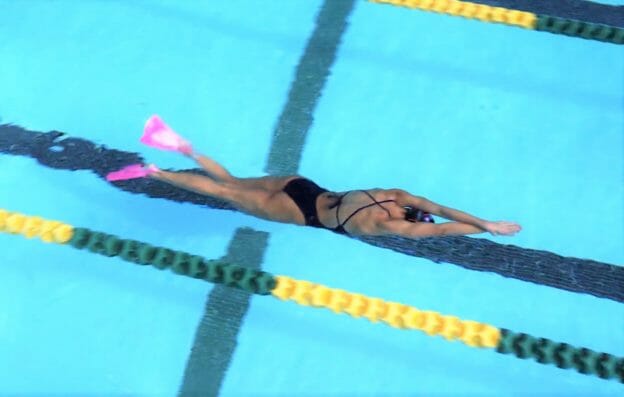At The Race Club, we look at the freestyle kicking speed as the baseline speed for your freestyle. In other words, your all-out kicking speed for 50 yards is your baseline freestyle speed for 50 yards, before you add in your pulling and coupling motions. It is true that the shorter the race, the greater the contribution the kick makes to the overall freestyle speed. Therefore, the more important the kick becomes. However, the kick is meaningful for most fast swimmers, no matter what the distance and particularly when you want to put your freestyle into high gear at the finish.
Several years ago, I was coaching a 34 year old sprinter from Northern Ireland, Andy Hunter, who was trying to qualify for the Commonwealth Games. His goal was to reach 23.0 for the 50 meter LC freestyle. His PB was 24.6 and I had 6 months to try to help him reach his goal. That is like trying to drop a minute off of one’s 1500 time. But I was committed to try and so was he.
He arrived from Ireland overweight, out of shape and with a 50 meter kicking time of 50 seconds. I told him he wouldn’t reach his goal of 23.0 unless he could kick 50 meters in 35 seconds or faster.
In one of the first test meets in Ft. Lauderdale after he had arrived, Andy swam the 50 free LC with Cesar Cielo in the same heat. Cesar swam a 22.0 and Andy finished about 7 meters behind him in 25.2. Andy left the pool feeling very dejected. He felt even more so after I showed him the video of the race with him around 7 meters from the wall when Cesar finished.
“How in world can he beat me by 7 meters in a 50 meter race,” he asked? “How can that happen?”
I explained it to him this way. By the time he raced in Ft Lauderdale, Andy’s kick time had dropped to 45 seconds, which is 1.1 meters per second. Cesar could kick the same distance in around 30 seconds, which is 1.67 meters per second. After adding in the pulling and coupling motions (stroke rate of 120), Cesar boosted his swimming speed to just under 2.3 meters per second in order to swim 22.0. Andy boosted his swimming speed with a 140 stroke rate to 1.98 meters per second to swim the same race in 25.2 seconds. In other words, Cesar added .6 meters per second to his baseline speed while Andy added nearly .9 meters per second to his baseline speed.
Good for Andy! Unfortunately, because his baseline speed was so low, he was still over .3 meters per second slower in overall speed than Cesar. So I asked Andy, how long was Cesar swimming?
“22 seconds,” he responded.
“And what is 22 x .3”, I asked?
“6.6 meters”…..which is precisely where Andy was away from the wall when Cesar finished.
After 5 months of training and lots of ankle stretching and hard kicking sets, Andy improved his kicking time for 50 meters to 38 seconds. In his shaved, tapered meet he swam a 23.2 for the 50 freestyle, just off of his goal time and narrowly missing making the Commonwealth Games. In spite of that, I was pretty proud of him and that bit of coaching.
The bottom line is if you want to swim faster, whether it is a 50 sprint or finishing a 1500 meter race with after burners on, work on your kicking speed. To do so requires extraordinary plantar ankle flexibility, tremendous leg strength, proper kicking mechanics, and lots of kicking work.
Part of the proper biomechanics of freestyle kicking entails how much to bend your knees. This week, in Lanes 3 and 4, you will find an interesting webisode that compares three techniques of normal, overbending, and underbending the knees in freestyle kicking. This is using Velocity Meter technology with a 13 year old age group swimmer. We hope you enjoy!
Yours in Kicking,
Gary Sr.
What is your Baseline Freestyle Speed?


“The bottom line is if you want to swim faster, whether it is a 50 sprint or finishing a 1500 meter race with after burners on, work on your kicking speed. To do so requires extraordinary plantar ankle flexibility, tremendous leg strength, proper kicking mechanics, and lots of kicking work.”
I tend to use less kicks during practice to save energy for thougher series, my brother does the opposite as he is stronger, I need to change this approach regardless of my limitations. Any specific dryland exercise for what you mentioned or just hard kicking sessions would suffice?
You need to work on ankle flexibility (freestyle squat sits or pushups), leg strength (leg extensors and hip extensors with straight legs) and lots and lots of kicking. The legs need to be conditioned more than the arms for swimming fast.
Gary
Would it be right to infer from your recommendation to Andy Hunter that kicking 50 meters about 50% slower than swimming goal time is a good metric? (23X1=35)
I had never looked at it that way, but for Andy, that turned out to be about right. The faster a swimmer becomes, the lower the factor becomes. Elite sprinters that swim the 50 meters, for example, in 22 seconds, might kick it in 29 or 30 seconds, while sprinters that swim it in 21 seconds, might kick it 27 seconds. Part of that is the challenge of reaching the Terminal Velocity in swimming. The closer we get to that velocity, the harder it becomes to reach it, due to the compounding frontal drag. Hope this makes sense.